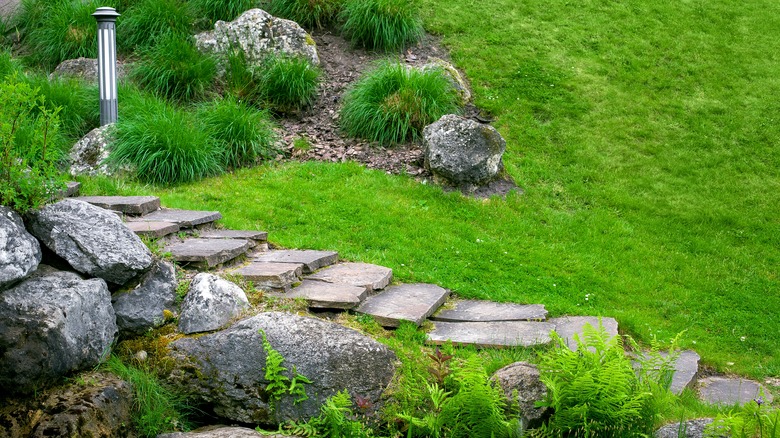Sometimes, we need to do our own research before following the most recent hack on TikTok. While there are simple solutions to fixing erosion on a sloped lawn, one TikTok trend is actually putting people and our environment at risk. This low-budget tip for preventing erosion that has taken the internet by storm recommends using railroad ties to reduce erosion on sloped lawns. However, railroad ties are typically sprayed with creosote, a chemical wood preservative proven by the EPA to be harmful to people and the environment.
It’s no secret that erosion can be a huge problem for homeowners and landowners. When erosion occurs, the top layer of topsoil is washed away, leaving the soil depleted, less fertile, and barren. Erosion is a massive problem because topsoil is vital for maintaining balance in the ecosystem. When topsoil runs off and erodes, it takes with it crucial nutrients, impacts the landscape, leads to desertification, and pollutes our precious waterways. In fact, according to the Natural Resources Defense Council (NRDC), it can take hundreds of years for even 1 inch of topsoil to develop naturally. The good news is that there are plenty of safe alternatives to using railroad ties that actually protect and uplift our ecosystems and communities instead of causing damage.
Why this TikTok hack is dangerous for residential areas
This is a steep slope and there was a lot of runoff. Water streamed down the street and down the driveway, washing out this area and gouging the gravel below. This is a very inexpensive and effective solution, though of course not high end. Top soil was added and planted with ferns, shasta daisies and catmint, in that order of shade to more light at the edge. Video done by Jack If you’re new here, I’m a garden coach and consultant based in the Boston area (zone 6b). Go to my website to learn more about what I do or to schedule consultations and more: https://www.youcandoitgardening.com #youcandoitgardening #erosion #gardeningtips #gardeningforbeginners #gardening #landscaping #gardening101 #gardeninghacks #retainingwall #gardentok
♬ original sound – You Can Do It Gardening
Watch on TikTok
Creosote is a known carcinogen typically used for wood preservation and treatment. According to the CDC, long-term exposure to creosote has been linked to cancer, lung and skin damage, light sensitivity, convulsions, liver toxicity, and even death. Typically, long-term exposure occurs in people who have worked in a wood-preserving facility or live near a wood-preserving facility that uses creosote. However, creosote is capable of leeching into the soil, waterways, and groundwater, posing a significant threat to our wildlife, ecosystems, and overall health.
Furthermore, if creosote-treated railroad ties are used for erosion control gardens in a residential landscape, the soil in the surrounding area can become contaminated. For example, if children are playing in the soil nearby and accidentally ingest soil, as children tend to do, they can be exposed to the toxicities of this carcinogenic chemical. Additionally, according to The Agency for Toxic Substances and Disease Registry (ATSDR), if creosote-treated wood is used even remotely near a body of water or a stream, it can contaminate the water and the aquatic life, posing a threat to the ecosystem and anyone who ingests creosote-contaminated fish or shellfish.
Nontoxic alternatives to using railroad ties to stop erosion

Clearly, this TikTok hack is not safe for residential areas as it poses a severe threat to our environment. However, plenty of natural and low-budget ways can help stop erosion on a sloped lawn. One of the best ways to prevent erosion naturally is by using native plants in your landscape! Native plants have evolved in their native landscape for thousands of years and have built an unshakeable level of resiliency that makes them drought-tolerant, low-maintenance, and invaluable to our local ecosystems. Instead of damaging our ecosystems, they actually help restore native habitats for birds, invertebrates, and small mammals. Native plants tend to have fibrous or deep taproots that trap water deep into the ground, reinvigorating topsoil and naturally combatting erosive forces.
However, when dealing with a sloped lawn and the inevitable gravitational pull, planting native plants alone will not do the trick. The best way to approach erosion control for a sloped yard is to create a retention wall using rocks, large stones, or naturally pest-resistant wood to create a barrier, then add native plants to help absorb the water as it travels down the slope. Using recycled materials like upcycled stones and naturally pest-resistant wood like pine or cedar is eco-friendly, budget-friendly, and provides a beautiful, rustic, non-toxic solution to erosion on a slope. However, before you start designing your eco-friendly erosion control garden, make sure you understand the principles of gardening on a slope!